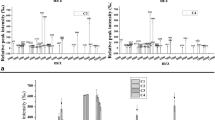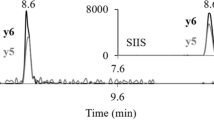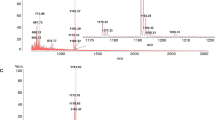Abstract
Enterotoxins produced by different species of the Bacillus cereus group, such as cytotoxin K1 (CytK1) and non-haemolytic enterotoxin (NHE), have been associated with diarrhoeal food poisoning incidents. Detection of CytK1 is not possible with commercial assays while NHE is recognised by an immunological kit (TECRA) that does not specifically target this protein because it is based on polyclonal antibodies. It is evident that the lack of suitable tools for the study of enterotoxins hampers the possibilities for accurate hazard identification and characterisation in microbial food safety risk assessment. We applied matrix-assisted laser desorption/ionisation time-of-flight mass spectrometry (MALDI-TOF/MS) for the detection of CytK1 and NHE produced by pathogenic strains of the B. cereus group using protein digests from 1D gel electrophoresis. Secretion of CytK1 and two of the three components of NHE was confirmed in supernatants of different B. cereus cultures. For each protein, we introduce biomarkers that could be used for the screening of food poisoning or food/environmental isolates that can secrete enterotoxins. For example, tryptic peptides of 2,310.2 and 1,192.5 Da (calculated mass) can be indicators for CytK1 and NheA, respectively, although a simultaneous detection of other enterotoxin-specific peptides is recommended to assure the presence of a toxin in an unknown sample. Comparison of MALDI-TOF/MS with the TECRA kit showed that our methodological strategy performed well and it had the competitive advantage of specifically detecting NheA. Therefore, MALDI-TOF/MS can be successfully incorporated into risk assessment procedures in order to determine the involvement of strains of the B. cereus group in foodborne outbreaks, including the recently described cytK1 producing species, Bacillus cytotoxicus.



Similar content being viewed by others
References
Priest FG, Barker M, Baillie LWJ, Holmes EC, Maiden MCJ (2004) J Bacteriol 186:7959–7970
Nicholson WL (2002) Cell Mol Life Sci 59:410–416
Choma C, Guinebretiere MH, Carlin F, Schmitt P, Velge P, Granum PE, Nguyen-The C (2000) J Appl Microbiol 88:617–625
Zhou GP, Liu HZ, He J, Yuan YM, Yuan ZM (2008) Int J Food Microbiol 121:195–200
Brychta J, Smola J, Pipek P, Ondracek J, Bednar V, Cizek A, Brychta T (2009) Czech J Food Sci 27:284–292
Lindback T, Fagerlund A, Rodland MS, Granum PE (2004) Microbiology-SGM 150:3959–3967
Vilas-Boas GT, Peruca APS, Arantes OMN (2007) Can J Microbiol 53:673–687
Arnesen LPS, Fagerlund A, Granum PE (2008) FEMS Microbiol Rev 32:579–606
Schraft H, Griffiths MW (2006) Bacillus cereus gastroenteritis. In: Riemann HP, Cliver DO (eds) Foodborne infections and intoxications. Academic, Amsterdam
Schoeni JL, Wong ACL (2005) J Food Protect 68:636–648
Agata N, Ohta M, Mori M, Isobe M (1995) FEMS Microbiol Lett 129:17–19
McKillip JL (2000) Int J Gen Mol Microbiol 77:393–399
Lund T, De Buyser ML, Granum PE (2000) Mol Microbiol 38:254–261
Beecher DJ, Macmillan JD (1991) Infect Immun 59:1778–1784
Lund T, Granum PE (1996) FEMS Microbiol Lett 141:151–156
Ngamwongsatit P, Buasri W, Pianariyanon P, Pulsrikam C, Ohba M, Assavanig A, Panbangred W (2008) IntJ Food Microbiol 121:352–356
Guinebretiere MH, Velge P, Couvert O, Carlin F, Debuyser ML, Nguyen-The C (2010) J Clin Microbiol 48:3388–3391
Ceuppens S, Rajkovic A, Heyndrickx M, Tsilia V, van De Wiele T, Boon N, Uyttendaele M (2011) Critl Rev Microbiol 37:188–213
Guinebretiere MH, Fagerlund A, Granum PE, Nguyen-The C (2006) FEMS Microbiol Lett 259:74–80
Ehling-Schulz M, Guinebretiere MH, Monthan A, Berge O, Fricker M, Svensson B (2006) FEMS Microbiol Lett 260:232–240
Wehrle E, Moravek M, Dietrich R, Burk C, Didier A, Martlbauer E (2009) J Microbiol Methods 78:265–270
Hansen BM, Hendriksen NB (2001) Appl Environ Microbiol 67:185–189
Guinebretiere MH, Broussolle V, Nguyen-The C (2002) J Clin Microbiol 40:3053–3056
Mantynen V, Lindstrom K (1998) Appl Environ Microbiol 64:1634–1639
Hardy SP, Lund T, Granum PE (2001) FEMS Microbiol Lett 197:47–51
Dietrich R, Moravek M, Burk C, Granum PE, Martlbauer E (2005) Appl Environ Microbiol 71:8214–8220
Kotiranta A, Lounatmaa K, Haapasalo M (2000) Microb Infect 2:189–198
Ankolekar C, Rahmati T, Labbe RG (2009) Int J Food Microbiol 128:460–466
Beecher DJ, Wong ACL (1994) Appl Environ Microbiol 60:4614–4616
Barr JR, Moura H, Boyer AE, Woolfitt AR, Kalb SR, Pavlopoulos A, McWilliams LG, Schmidt JG, Martinez RA, Ashley DL (2005) Emerg Infect Dis 11:1578–1583
Boyer AE, Gallegos-Candela M, Lins RC, Kuklenyik Z, Woolfitt A, Moura H, Kalb S, Quinn CP, Barr JR (2011) Molecules 16:2391–2413
Sospedra I, Soler C, Manes J, Soriano JM (2011) Anal Bioanal Chem 400:1525–1531
Haggblom MM, Apetroaie C, Andersson MA, Salkinoja-Salonen MS (2002) Appl Environ Microbiol 68:2479–2483
Hoton FM, Fornelos N, N’Guessan E, Hu XM, Swiecicka I, Dierick K, Jaaskelainen E, Salkinoja-Salonen M, Mahillon J (2009) Environ Microbiol Reports 1:177–183
Gohar M, Okstad OA, Gilois N, Sanchis V, Kolsto AB, Lereclus D (2002) Proteomics 2:784–791
Gilois N, Ramarao N, Bouillaut L, Perchat S, Aymerich S, Nielsen-LeRoux C, Lereclus D, Gohar M (2007) Proteomics 7:1719–1728
Moravek M, Dietrich R, Buerk C, Broussolle V, Guinebretiere MH, Granum PE, Nguyen-The C, Martlbauer E (2006) FEMS Microbiol Lett 257:293–298
Beecher DJ, Wong ACL (1994) Infect Immun 62:980–986
Fagerlund A, Brillard J, Furst R, Guinebretiere MH, Granum PE (2007) BMC Microbiol 7(43)
Nedelkov D, Nelson RW (2003) Appl Environ Microbiol 69:5212–5215
Hennekinne JA, Brun V, De Buyser ML, Dupuis A, Ostyn A, Dragacci S (2009) Appl Environ Microbiol 75:882–884
Jaaskelainen EL, Haggblom MM, Andersson MA, Vanne L, Salkinoja-Salonen MS (2003) J Food Protect 66:1047–1054
Biesta-Peters EG, Reij MW, Blaauw RH, in’t Veld PH, Rajkovic A, Ehling-Schulz M, Abee T (2010) Appl Environ Microbiol 76:7466–7472
Auger S, Galleron N, Bidnenko E, Ehrlich SD, Lapidus A, Sorokin A (2008) Appl Environ Microbiol 74:1276–1280
Guinebretiere MH, Auger S, Galleron N, Contzen M, De Sarrau B, De Buyser M-L, Lamberet G, Fagerlund A, Granum PE, Lereclus D, De Vos P, Nguyen-The C, Sorokin A (2012) Int J Syst Evol Microbiol (in press)
Fagerlund A, Ween A, Lund T, Hardy SP, Granum PE (2004) Microbiology-SGM 150:2689–2697
Rivera AMG, Granum PE, Priest FG (2000) FEMS Microbiol Lett 190:151–155
Ehling-Schulz M, Svensson B, Guinebretiere MH, Lindback T, Andersson M, Schulz A, Fricker M, Christiansson A, Granum PE, Martlbauer E, Nguyen-The C, Salkinoja-Salonen M, Scherer S (2005) Microbiology-SGM 151:183–197
Granum PE, O’Sullivan K, Lund T (1999) FEMS Microbiol Lett 177:225–229
Krause N, Moravek M, Dietrich R, Wehrle E, Slaghuis J, Martlbauer E (2010) Int J Food Microbiol 144:322–326
Acknowledgements
We thank Prof. N. Boon for the critical revisions of this manuscript. This work was financially supported by the Belgian Federal Public Service (FOD) of Health, Food Chain Safety and Environment (RT09/2 BACEREUS) and the Special Research Funds of Ghent University (B/09036/02 fund IV1 31/10/2008–31/10/2012). Bart Devreese is indebted to the Belgian Federal Government-Interuniversity Attraction Pole Action P6/19 and a GOA grant from Ghent University Research Funds. Tom Van de Wiele and Andreja Rajkovic are Postdoctoral Fellows belonging to the Fund for Scientific Research (FWO) of Flanders (Belgium). The authors have declared no conflict of interest.
Author information
Authors and Affiliations
Corresponding author
Rights and permissions
About this article
Cite this article
Tsilia, V., Devreese, B., de Baenst, I. et al. Application of MALDI-TOF mass spectrometry for the detection of enterotoxins produced by pathogenic strains of the Bacillus cereus group. Anal Bioanal Chem 404, 1691–1702 (2012). https://doi.org/10.1007/s00216-012-6254-6
Received:
Revised:
Accepted:
Published:
Issue Date:
DOI: https://doi.org/10.1007/s00216-012-6254-6




